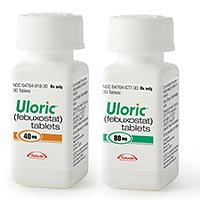COMPANY: Takeda
PHARMACOLOGIC CLASS: Xanthine oxidase inhibitor
ACTIVE INGREDIENT: Febuxostat 40mg, 80mg; tabs.
INDICATION: Chronic management of hyperuricemia in patients with gout.
PHARMACOLOGY: Gout is a chronic condition characterized by attacks, or “flares,” that are marked by intense pain, redness, swelling, and heat in the affected joint. These symptoms are caused by the buildup of uric acid, which crystallizes and deposits under the skin and in joints. Gout is the most common inflammatory arthritis presented in men over 40 years of age. Febuxostat exerts its therapeutic effect by blocking the enzyme xanthine oxidase. Xanthine oxidase is responsible for the breakdown of the purine base, hypoxanthine, to xanthine and subsequently to uric acid. By blocking this enzyme, febuxostat helps to prevent the production of uric acid, thereby reducing the elevated levels of serum uric acid.
CLINICAL TRIALS: Three randomized, double-blind, controlled clinical studies evaluated the efficacy of daily treatment with febuxostat compared to that of allopurinol 300mg daily, or placebo in 3402 patients with hyperuricemia and gout. Hyperuricemia was defined as a baseline serum uric acid level ≥8mg/dL. In all 3 studies, patients also received naproxen 250mg twice daily or colchicine 0.6mg once or twice daily for gout flare prophylaxis. The primary efficacy endpoint was the proportion of patients with a serum uric acid level <6mg/dL at the final visit. Febuxostat 40mg demonstrated comparable efficacy to allopurinol in lowering serum uric acid to <6mg/dL at the final visit; whereas febuxostat 80mg demonstrated superior efficacy. Of the patients treated with febuxostat 80mg, 76% achieved a serum uric acid level <6mg/dL by week 2 and 83% of these patients maintained average serum uric acid levels of <6mg/dL throughout the treatment period.
ADULTS: ≥18yrs: initially 40mg once daily; if serum uric acid is not <6mg/dL after 2 weeks, may increase to 80mg once daily. Gout flare prophylaxis, with an NSAID or colchicine, upon initiation of therapy and for up to 6 months, is recommended.
CHILDREN: <18yrs: not recommended.
CONTRAINDICATIONS: Concomitant azathioprine, mercaptopurine, theophylline.
PRECAUTIONS: Not recommended for treating asymptomatic hyperuricemia. Cardiovascular events: monitor for signs and symptoms of MI and stroke. Severe renal impairment or ESRD on dialysis. Severe hepatic impairment. Monitor liver function at 2 and 4 months after initiation and periodically thereafter. Obtain target serum uric acid levels <6mg/dL after 2 weeks of initiating therapy. Secondary hyperuricemia (eg, Lesch-Nyhan syndrome, malignant disease, or in organ transplant recipients): not recommended. Pregnancy (Cat.C). Nursing mothers.
INTERACTIONS: See Contraindications. Potentiates xanthine oxidase substrate drugs.
ADVERSE REACTIONS: Liver function abnormalities, nausea, arthralgia, rash, gout flares.
NOTE: Report suspected adverse reactions to Takeda at (877) 825-3327 or FDA at (800) FDA-1088.
HOW SUPPLIED: Tabs 40mg—30, 90, 500; 80mg—30, 100, 1000 For more information call (877) 825-3327 or visit www.Uloric.com
